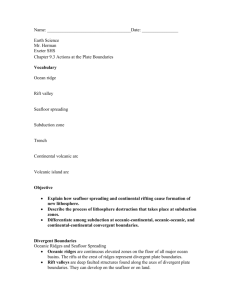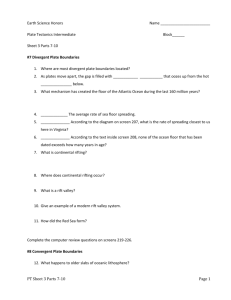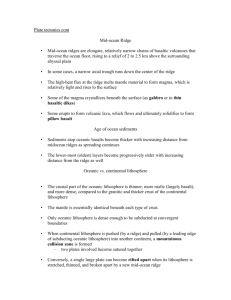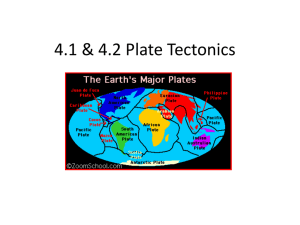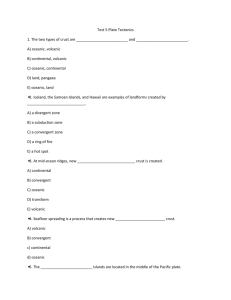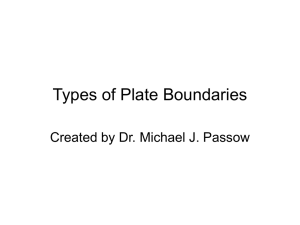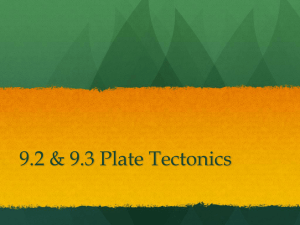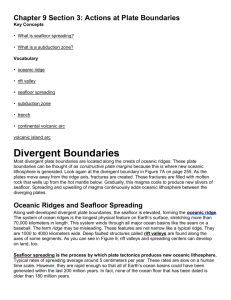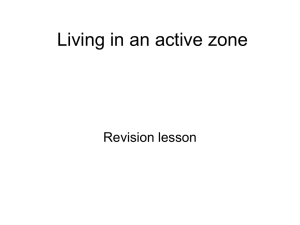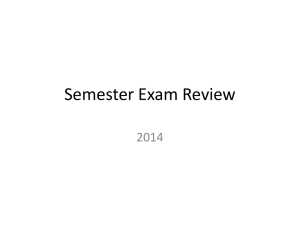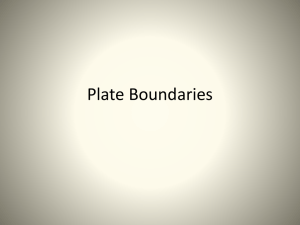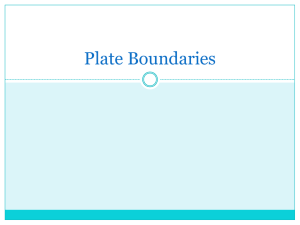Ch 9 3 Actions at Plate Boundaries
advertisement
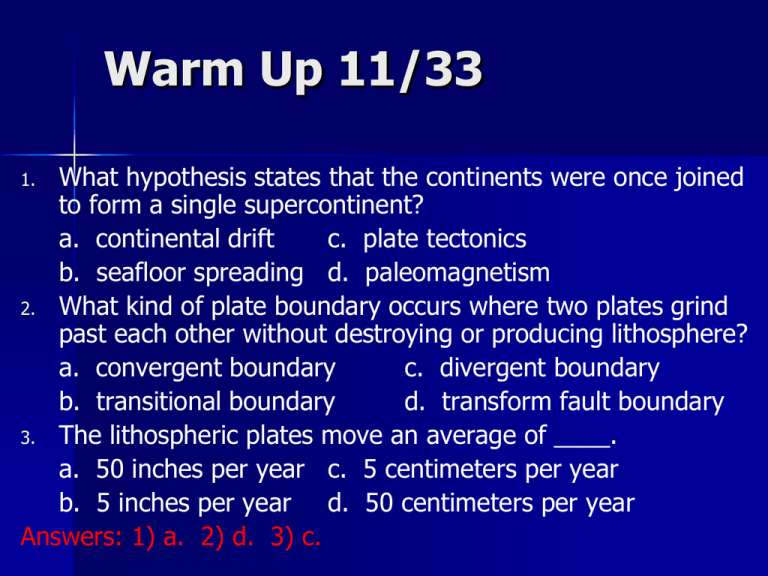
Warm Up 11/33 What hypothesis states that the continents were once joined to form a single supercontinent? a. continental drift c. plate tectonics b. seafloor spreading d. paleomagnetism 2. What kind of plate boundary occurs where two plates grind past each other without destroying or producing lithosphere? a. convergent boundary c. divergent boundary b. transitional boundary d. transform fault boundary 3. The lithospheric plates move an average of ____. a. 50 inches per year c. 5 centimeters per year b. 5 inches per year d. 50 centimeters per year Answers: 1) a. 2) d. 3) c. 1. Actions at Plate Boundaries Chapter 9, Section 3 Divergent Boundaries Most divergent boundaries are located along the crests of oceanic ridges These plate boundaries can be thought of as constructive plate boundaries, because it is where new oceanic lithosphere is created Location of Most Divergent Boundaries Oceanic Ridges and Seafloor Spreading Oceanic Ridge – along well-developed divergent plate boundaries, area where seafloor is elevated The system of ridges is the longest physical feature on Earth’s surface (70,000 km long) These features are 1000 to 4000 km wide, not narrow at all Rift Valley – Deep faulted structures found along the ridge system Seafloor Spreading – process by which plate tectonics produces new lithosphere Typically the rates of spreading average about 5 cm/year, fast enough that all of the current oceans have been produced in the last 200 million years Seafloor Spreading Continental Rifts When spreading centers develop within a continent, the landmass may split into two or more smaller segments The most widely accepted view is that areas where plumes of hot rock rise from the mantle are weaker then other areas, stretching the areas above it causing faulting and volcanism In the East African rift valley, the beginning stages of continental breakup may be occurring creating the Red Sea East African Rift Valleys Concept Check How do rifts begin to form? The lithosphere is stretched and a plume of hot rock from the mantle weakens and then splits the lithosphere Convergent Boundaries Because lithosphere is being “destroyed” at convergent boundaries, they are also called destructive plate margins Subduction Zones – destructive plate margins where oceanic crust is being pushed down into the mantle Trench – Surface feature produced by descending slab, some of the deepest spots on Earth Convergent boundaries are controlled by the type of crust involved in the convergence Oceanic-Continental Convergence When a continental plate meets an oceanic plate, the less dense continental plate remains floating as the oceanic plate is pushed underneath When the descending plate reaches a depth of ~100-150 km, some of the surrounding material will begin to melt, forming magma Some of this magma may reach the surface and cause volcanic eruptions Continental Volcanic Arc – mountains produced by the volcanic activity that is caused by the subduction of oceanic lithosphere under continental (Andes Mountains) Oceanic-Continental Convergence Oceanic-Oceanic Convergence When two oceanic slabs converge, one descends below the other This causes volcanic activity similar to the oceanic-continental boundary, with the volcanoes forming on the ocean floor instead It will eventually form a chain of volcanic structures that will become islands Volcanic Island Arc – newly formed land consisting of an arc-shaped chain of small volcanic islands (Aleutian Islands, Alaska) Oceanic-Oceanic Convergence Continental-Continental Convergence Eventually, subduction may bring two continents together and a collision occurs The result of this collision is usually seen in the form of complex mountains such as the Himalayas in South Asia When the continents collide, after all of an ocean basin between them has been subducted, the collision folds and deforms the sediments along the margin A mountain chain forms that is composed of deformed and metamorphosed sedimentary rocks The Himalayas, Alps, Appalachians, and Urals were all formed by this process Continental-Continental Convergence Collision of India and Asia Concept Check What happens when continents collide? Mountains form as the lithosphere is forced upward Transform Fault Boundaries At a transform fault boundary, plates grind past each other without destroying lithosphere Most transform faults join two segments of mid-ocean ridges, present about every 100 km along the ridge axes The seafloor produced at one ridge axis moves in the opposite direction as the seafloor produced at an opposing ridge segment, and these segments grind past each other on their ways Most transform faults are found within the ocean basins, a few cut through the continental crust (San Andreas Fault) Transform Faults The Role of Transform Faults The World’s Oceanic Trenches, Ridge System, and Transform Faults Assignment Chapter 9 Assessment P. 275 – 276 # 1 – 31 P. 277 # 1 – 9
